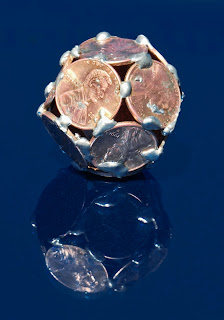I've currently moved over to blogging at http://mathcraft.wonderhowto.com/
Here I will be posting about 4 times per week and will have a project every week with more in depth information and a how to component and templates. There will also be a user forum for people to submit pictures and ideas.
Thanks! I hope to see you there!
Platonic and Archimedean Solids from Coins
A couple of weeks ago, I suddenly had the idea to make the Platonic solids out of pennies. I'd made them before out of paper in several variations, and had seen them made out of many different materials, but I hadn't seen them made from coins. I also quickly thought of making the Archimedean solids from 2 or more types of coins and discovered that the ratio of diameters between pennies and quarters is perfect for making a truncated icosahedron which is the design most often used for a soccer ball. The ratios between dimes and half-dollars would allow you to make any polyhedron composed of just triangles and squares of which there are 3 among the Archimedean solids but I haven't attempted these yet. Once I have made these, I will have exhausted the list that can be made by only using US coins.
The building process was harder than I though. I soldered them together using folded paper nets to set the angles. As the number of coins increases, the amount of mass makes it difficult to heat the coins up enough to get pretty bonds between the coins. Also heating the coins to the proper temperature was also causing some discoloration. Still, while not perfectly pretty, the bonds are quite strong and I now use them instead of a coin to make all of my random decisions. The cube feels the best for this as it is the shape of the common die.
Here are some pictures. Click on them for higher resolution versions.
All 5 platonic solids. I call this picture Fiddy Cent for the obvious reason.
The Regular Tetrahedron (4 sides)
The Regular Hexahedron or Cube (6 sides)
The Regular Octahedron (8 sides)
The Regular Dodecaheron (12 Sides)
The Regular Icosahedron (20 Sides)
Notice the Gaps in the above picture. Now if you take those pennies and replace them with quarters the gaps are almost the exact size of pennies. That's what I did to make the object below.
The Truncated Icosahedron. 32 Sides. 20 Quarters and 12 Pennies.
That's why I call this Five Dollars and Twelve Cents.
That's why I call this Five Dollars and Twelve Cents.
All 6 of them together.
Subscribe to:
Post Comments (Atom)
Popular Posts
-
This post is going to be on 3D fractals cut on a scroll saw. (Thus the title of course.) As some of you know, I'm somewhat addicted to...
-
I've been a big fan of M.C. Escher's Art since I was a little kid. His impossible figures drawings are mindblowing and his tesselat...
-
It's the middle of April and this next week all students at University Preparatory School , where I teach, will be taking the California...
-
I've always been interested in maps and different projections and how they make such a difference in the way the world looks when a sphe...
-
I ran across an article a couple of months ago talking about an artist making cityscapes using staples to build the buildings. The cities w...
-
A couple of weeks ago, I suddenly had the idea to make the Platonic solid s out of pennies. I'd made them before out of paper in severa...
-
I've been a big fan of George Hart's geometric sculptures for a while now and so a few weeks back I decided I would build his Frabjo...
-
I finally finished a papercraft project I've been working on for about a month. It's made up of parts of 29 sheets of cardstock. I...
-
This post combines two of my hobbies, making things out of paper (papercrafting) and exploring and building fractals. For those of you that...
-
I spent a little bit of time on the wooden orrery today. Click here for the original post and description . Two more sets of Gears are done...





















0 comments:
Post a Comment